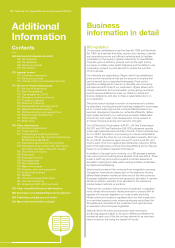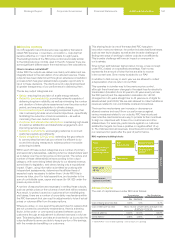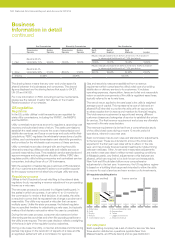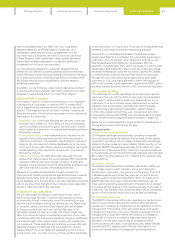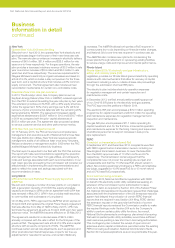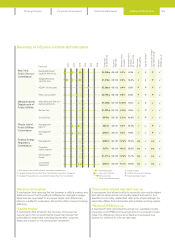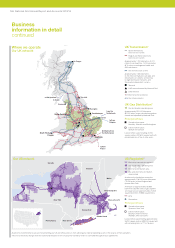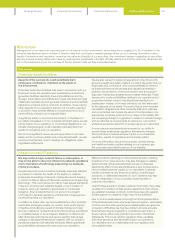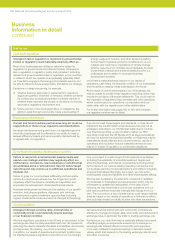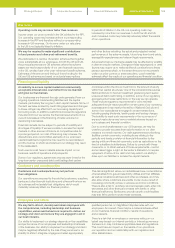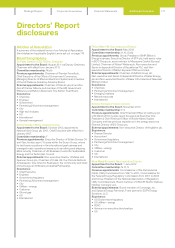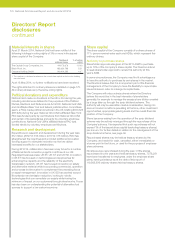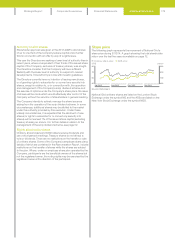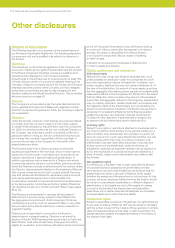National Grid 2014 Annual Report Download - page 169
Download and view the complete annual report
Please find page 169 of the 2014 National Grid annual report below. You can navigate through the pages in the report by either clicking on the pages listed below, or by using the keyword search tool below to find specific information within the annual report.
Strategic Report Corporate Governance Financial Statements Additional Information
Risk factors
Management of our risks is an important part of our internal control environment, as we describe on pages 22 to 25. In addition to the
principal risks listed we face a number of inherent risks that could have a material adverse effect on our business, financial condition,
results of operations and reputation, as well as the value and liquidity of our securities. Any investment decision regarding our securities
and any forward-looking statements made by us should be considered in the light of these risk factors and the cautionary statement set
out on the inside back cover. An overview of the key inherent risks we face is provided below.
Risk factors
Potentially harmful activities
Aspects of the work we do could potentially harm
employees, contractors, members of the public or
theenvironment.
Potentially hazardous activities that arise in connection with our
business include the operation and maintenance of electricity
generation facilities, electricity lines and substations and the
storage, transmission and distribution of gas. Electricity and gas
utilities also typically use and generate hazardous and potentially
hazardous products and by-products. In addition, there may be
other aspects of our operations that are not currently regarded
orproved to have adverse effects but could become so, such
asthe effects of electric and magnetic fields.
A significant safety or environmental incident, or the failure of
oursafety processes or of our occupational health plans, as well
as the breach of our regulatory or contractual obligations or our
climate change targets, could materially adversely affect our
results of operations and our reputation.
We commit significant resources and expenditure to process
safety and to monitoring safety and occupational health, as well
as environmental risks, and to meeting our obligations under
negotiated settlements.
We are also subject to laws and regulations in the UK and US
governing health and safety matters to protect the public and our
employees and contractors, who could potentially be harmed
bythese activities as well as laws and regulations relating to
pollution, the protection of the environment, and the use and
disposal of hazardous substances and waste materials. These
expose us to costs and liabilities relating to our operations and
properties whether current, including those inherited from
predecessor bodies, or formerly owned by us, and sites used
forthe disposal of our waste. The cost of future environmental
remediation obligations is often inherently difficult to estimate
and uncertainties can include the extent of contamination, the
appropriate corrective actions and our share of the liability. We
are increasingly subject to regulation in relation to climate change
and are affected by requirements to reduce our own carbon
emissions as well as reduction in energy use by ourcustomers.
If more onerous requirements are imposed or our ability to
recover these costs under regulatory frameworks changes,
thiscould have a material adverse impact on our business,
reputation, results of operations and financial position.
For more information about environmental, climate change
andhealth and safety matters relating to our business, see
thecorporate responsibility section of our website.
Infrastructure and IT systems
We may suffer a major network failure or interruption, or
maynot be able to carry out critical non-network operations
due to the failure of technology supporting our business-
critical processes.
Operational performance could be materially adversely affected
by a failure to maintain the health of the system or network,
inadequate forecasting of demand, inadequate record keeping
orcontrol of data or failure of information systems and supporting
technology. This could cause us to fail to meet agreed standards
of service, incentive and reliability targets, or be in breach of
alicence, approval, regulatory requirement or contractual
obligation. Even incidents that do not amount to a breach
couldresult in adverse regulatory and financial consequences,
as well as harming our reputation.
In addition to these risks, we may be affected by other potential
events that are largely outside our control, such as the impact
ofweather (including as a result of climate change and major
storms), unlawful or unintentional acts of third parties, insufficient
or unreliable supply or force majeure. Weather conditions can
affect financial performance and severe weather that causes
outages or damages infrastructure together with our actual or
perceived response will materially adversely affect operational
and potentially business performance and our reputation.
Malicious attack, sabotage or other intentional acts, including
breaches of our cyber security, may also damage our assets
(which include critical national infrastructure) or otherwise
significantly affect corporate activities and, as a consequence,
have a material adverse impact on our reputation, business,
results of operations and financial condition. Unauthorised
access to, or deliberate breaches of, our IT systems may also
lead to manipulation of our proprietary business data or
customer information.
Unauthorised access to private customer information may make
us liable for a violation of data privacy regulations. Even where
we establish business continuity controls and security against
threats against our systems, these may not be sufficient.
Due to control weaknesses occurring from the implementation
ofthe US business’s new enterprise resource system, associated
controls over financial reporting and related system programme
conversion difficulties, we may be unable to provide accurate
financial reporting and regulatory compliance reporting in a
timely manner, which may include the provision of financial
statements. This could result in regulatory fines, penalties,
andother sanctions and adversely impact our operations,
ourreputation and our relationship with our regulators and
otherstakeholders.
167





